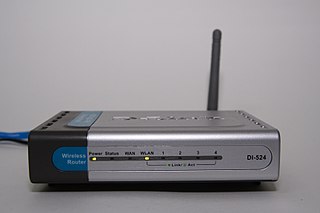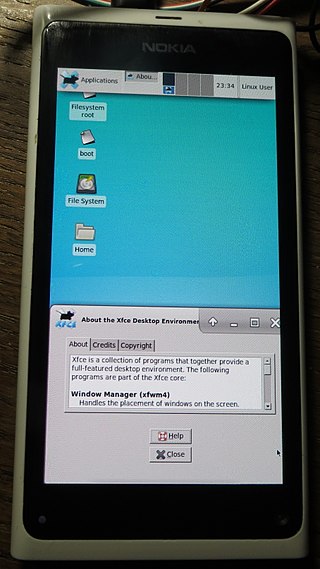Related Research Articles

Unified Extensible Firmware Interface is a specification for the firmware architecture of a computing platform. When a computer is powered on, the UEFI-implementation is typically the first that runs, before starting the operating system. Examples include AMI Aptio, Phoenix SecureCore, TianoCore EDK II, InsydeH2O.

The Linksys WRT54G Wi-Fi series is a series of Wi-Fi–capable residential gateways marketed by Linksys, a subsidiary of Cisco, from 2003 until acquired by Belkin in 2013. A residential gateway connects a local area network to a wide area network.

coreboot, formerly known as LinuxBIOS, is a software project aimed at replacing proprietary firmware found in most computers with a lightweight firmware designed to perform only the minimum number of tasks necessary to load and run a modern 32-bit or 64-bit operating system.

A wireless router or Wi-Fi router is a device that performs the functions of a router and also includes the functions of a wireless access point. It is used to provide access to the Internet or a private computer network. Depending on the manufacturer and model, it can function in a wired local area network, in a wireless-only LAN, or in a mixed wired and wireless network.
In the context of free and open-source software, proprietary software only available as a binary executable is referred to as a blob or binary blob. The term usually refers to a device driver module loaded into the kernel of an open-source operating system, and is sometimes also applied to code running outside the kernel, such as system firmware images, microcode updates, or userland programs. The term blob was first used in database management systems to describe a collection of binary data stored as a single entity.
The DG834 series are popular ADSL modem router products from Netgear. The devices can be directly connected to a phone line and establish an ADSL broadband Internet connection to an internet service provider (ISP) and share it among several computers via 802.3 Ethernet and 802.11b/g wireless data links.

The hacking of consumer electronics is a common practice that users perform to customize and modify their devices beyond what is typically possible. This activity has a long history, dating from the days of early computer, programming, and electronics hobbyists.
OpenWrt is an open-source project for embedded operating systems based on Linux, primarily used on embedded devices to route network traffic. The main components are Linux, util-linux, musl, and BusyBox. All components have been optimized to be small enough to fit into the limited storage and memory available in home routers.
OpenConnect is a free and open-source cross-platform multi-protocol virtual private network (VPN) client software which implement secure point-to-point connections.

Libreboot is a free and open-source software project based on coreboot, aimed at replacing some of the proprietary BIOS or UEFI firmware on supported X86-64- and AArch64-based computers. Libreboot performs the basic machine setup such as CPU initialization or memory controller initialization necessary to load and run a 32-bit or 64-bit operating system, such as Linux or FreeBSD.
Custom firmware, also known as aftermarket firmware, is an unofficial new or modified version of firmware created by third parties on devices such as video game consoles, mobile phones, and various embedded device types to provide new features or to unlock hidden functionality. In the video game console community, the term is often written as custom firmware or simply CFW, referring to an altered version of the original system software inside a video game console such as the PlayStation Portable, PlayStation 3, PlayStation Vita/PlayStation TV, PlayStation 4, Nintendo 3DS, Wii U and Nintendo Switch. Installing custom firmware on some devices requires bootloader unlocking.

Librem is a line of computers manufactured by Purism, SPC featuring free (libre) software. The laptop line is designed to protect privacy and freedom by providing no non-free (proprietary) software in the operating system or kernel, avoiding the Intel Active Management Technology, and gradually freeing and securing firmware. Librem laptops feature hardware kill switches for the microphone, webcam, Bluetooth and Wi-Fi.
Pine Store Limited, doing business as Pine64, is a Hong Kong-based organization that designs, manufactures, and sells single-board computers, notebook computers, as well as smartwatch/smartphones. Its name was inspired by the mathematical constants π and e with a reference to 64-bit computing power.

Purism, SPC is an American computer technology corporation based in San Francisco, California and registered in the state of Washington.

postmarketOS is an operating system primarily for smartphones, based on the Alpine Linux distribution.
Marlin is open source firmware originally designed for RepRap project FDM 3D printers using the Arduino platform.

The PinePhone is a smartphone developed by Hong Kong–based computer manufacturer Pine64, designed to provide users with full control over the device. This is achieved through the utilization of mainline Linux-based mobile operating systems, assembly of the phone using screws, and facilitating simplified disassembly for repairs and upgrades. The 2G-4GLTE modem, GPS, Wi-Fi, Bluetooth and both cameras can be physically switched off. The PinePhone ships with the Manjaro Linux operating system using the Plasma Mobile graphic interface, although other distributions can be installed by users.

The PinePhone Pro is a smartphone developed by Hong Kong–based computer manufacturer Pine64. The phone is the successor to the PinePhone released in 2019. The default operating system is Sailfish OS. The device is a developer platform with open hardware specifications but with unfinished software. The target group of the device is free and open-source software developers who will develop the software. The device was first shipped to developers in December 2021, and in February 2022 devices were made available to consumers.
References
- ↑ Williams, Elliot (2022-05-14). "Who Is Thinking About Open Source Firmware?". Hackaday . Retrieved 2022-10-22.
- ↑ Banik, Subrata (2022). System firmware: an essential guide to open source and embedded solutions. Vincent Zimmer. ISBN 978-1-4842-7939-7. OCLC 1347731078.
- ↑ Ridley, Jacob (2022-04-13). "There's huge potential for this 'unbrickable' open source BIOS now it's running on modern Intel PCs". PC Gamer. Retrieved 2022-10-22.
- ↑ Andreas Giencke (25 September 2022). "How to Set Up & Edit Marlin Firmware". All3DP. Retrieved 19 June 2023.
- ↑ By (2022-07-12). "Open Firmware For PinePhone LTE Modem – What's Up With That?". Hackaday. Retrieved 2022-10-22.
- ↑ Shawn Powers (April 2008). "Linux Journal 2008 04 : Free Download, Borrow, and Streaming : Internet Archive". Internet Archive. Retrieved 19 June 2023.
